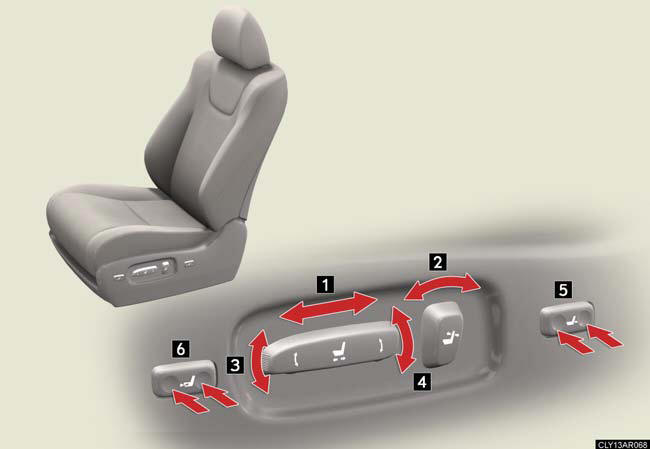Front seats

1. Seat position adjustment switch.
2. Seatback angle adjustment switch.
3. Seat cushion (front) angle adjustment switch.
4. Vertical height adjustment switch.
5. Lumbar support adjustment switch.
6. Seat cushion length adjustment switch (if equipped).
Flattening the front seatbacks
Before flattening the front seatbacks
Slide the rear seats as far back as possible.
Flattening the front seatbacks

Move the front seat forward, raise the seat, and remove the head restraint.
After returning the seat to its original position, make sure to replace the head restraint.

Move the seatback angle adjustment switch backward to flatten the seatback.
Power easy access system (vehicles with driving position memory)
When the driver enters and exits the vehicle, the driver's seat and steering wheel will automatically perform the following operations:

Exiting the vehicle: When all of the
following actions have been performed,
the steering wheel will
move up and back to the point farthest
away from the driver and the
seat will move backward (auto
away function):
• The shift lever has been shifted to P.
• The “POWER” switch has been turned off.
• The driver seat belt has been unfastened.
Entering the vehicle: When either
of the following actions has been
performed, the steering wheel will
move toward the driver and seat
will move forward (auto return
function):
• The “POWER” switch has been
turned to ACCESSORY mode.
• The driver seat belt has been fastened.
Active head restraints

When the occupant’s lower back presses against the seatback during a rear-end collision, the head restraint moves slightly forward and upward to help reduce the risk of whiplash to the seat occupant.
The auto away function for exiting the driver seat
If the seat is already close to the rearmost position, the auto away function
may not
operate when the driver exits the vehicle.
Active head restraints
Even small forces applied to the seatback may cause the head restraint to move.
Pushing up a locked head restraint forcibly may appear the head restraint inner structure. These do not indicate problems.

Customization
The distance that the driver’s seat moves backward during the auto away
function
can be changed.
CAUTION:
Seat adjustment
To reduce the risk of sliding under the lap belt during a collision, do not
recline the
seat more than necessary.
If the seat is too reclined, the lap belt may slide past the hips and apply
restraint
forces directly to the abdomen, or your neck may contact the shoulder belt,
increasing the risk of death or serious injury in the event of an accident.
Adjustments should not be made while driving as the seat may unexpectedly move and cause the driver to lose control of the vehicle.
While driving
Do not allow passengers to ride on the flattened seat.
See also:
Immobilizer system
The vehicle's keys have built-in transponder chips that prevent the hybrid
system from starting if the key has not been previously registered in the
vehicle's on-board computer.
Never leave the key ...
Automatic Transmission
Select a shift position appropriate for the driving conditions.
Shifting the shift lever
While the “ENGINE
START STOP” switch is
in IGNITION ON
mode, depress the brake
pedal and move the shift ...
Overview
The Lexus ES 350 debuts revised styling, new luxury amenities and the all-new
telematics system, Lexus Enform™ and Safety Connect™, for 2010. Newly standard
rear seat-mounted side airbags bring th ...
